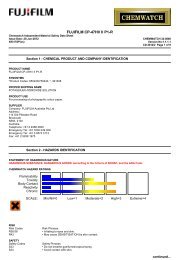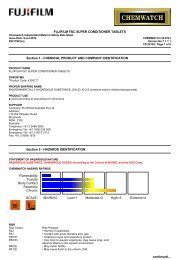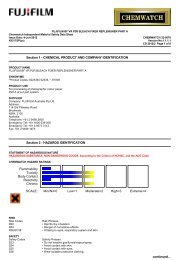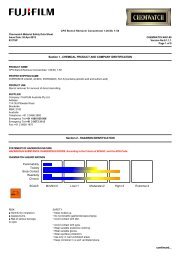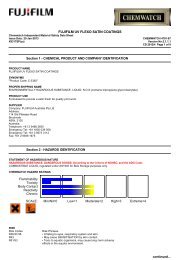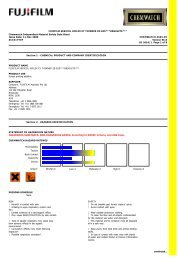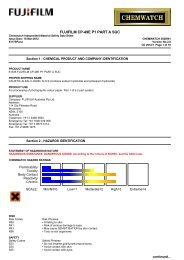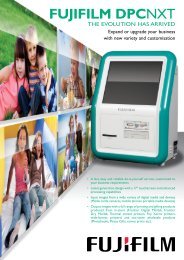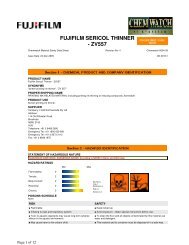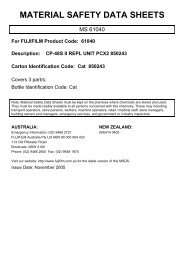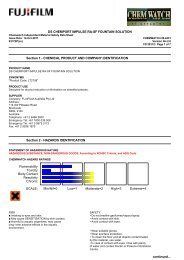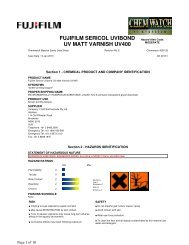Chemwatch Australian MSDS 34-5284 - FUJIFILM Australia
Chemwatch Australian MSDS 34-5284 - FUJIFILM Australia
Chemwatch Australian MSDS 34-5284 - FUJIFILM Australia
You also want an ePaper? Increase the reach of your titles
YUMPU automatically turns print PDFs into web optimized ePapers that Google loves.
<strong>FUJIFILM</strong> UVIJET UVISTAR QN - QN00B<br />
<strong>Chemwatch</strong> Independent Material Safety Data Sheet<br />
Issue Date: 19-Mar-2013 CHEMWATCH <strong>34</strong>-<strong>5284</strong><br />
X9317SP<br />
Version No:3.1.1.1<br />
CD 2013/1 Page 1 of 10<br />
Section 1 - CHEMICAL PRODUCT AND COMPANY IDENTIFICATION<br />
PRODUCT NAME<br />
<strong>FUJIFILM</strong> UVIJET UVISTAR QN - QN00B<br />
SYNONYMS<br />
"Product Code: QN052"<br />
PROPER SHIPPING NAME<br />
ENVIRONMENTALLY HAZARDOUS SUBSTANCE, LIQUID, N.O.S.(contains (5-ethyl-1,3-dioxan-5-yl)methyl acrylate)<br />
PRODUCT USE<br />
Ink jet printing ink.<br />
SUPPLIER<br />
Company: <strong>FUJIFILM</strong> <strong>Australia</strong> Pty Ltd<br />
Address:<br />
114 Old Pittwater Road<br />
Brookvale<br />
NSW, 2100<br />
<strong>Australia</strong><br />
Telephone: +61 2 9466 2600<br />
Emergency Tel: +61 1800 039 008<br />
Emergency Tel: +61 3 9573 3112<br />
Fax: +61 2 9938 1975<br />
Section 2 - HAZARDS IDENTIFICATION<br />
STATEMENT OF HAZARDOUS NATURE<br />
HAZARDOUS SUBSTANCE. DANGEROUS GOODS. According to the Criteria of NOHSC, and the ADG Code.<br />
CHEMWATCH HAZARD RATINGS<br />
Flammability<br />
Toxicity<br />
Body Contact<br />
Reactivity<br />
Chronic<br />
SCALE: Min/Nil=0 Low=1 Moderate=2 High=3 Extreme=4<br />
RISK<br />
Risk Codes<br />
Risk Phrases<br />
R36/37/38<br />
• Irritating to eyes, respiratory system and skin.<br />
R43<br />
• May cause SENSITISATION by skin contact.<br />
R51/53 • Toxic to aquatic organisms, may cause long- term adverse<br />
effects in the aquatic environment.<br />
R62(3)<br />
• Possible risk of impaired fertility.<br />
continued...
<strong>FUJIFILM</strong> UVIJET UVISTAR QN - QN00B<br />
<strong>Chemwatch</strong> Independent Material Safety Data Sheet<br />
Issue Date: 19-Mar-2013 CHEMWATCH <strong>34</strong>-<strong>5284</strong><br />
X9317SP<br />
Version No:3.1.1.1<br />
CD 2013/1 Page 2 of 10<br />
Section 2 - HAZARDS IDENTIFICATION<br />
SAFETY<br />
Safety Codes<br />
S23<br />
S24<br />
S25<br />
S36<br />
S37<br />
S39<br />
S53<br />
S29<br />
S401<br />
S35<br />
S13<br />
S26<br />
S46<br />
S57<br />
S61<br />
S60<br />
Safety Phrases<br />
• Do not breathe gas/fumes/vapour/spray.<br />
• Avoid contact with skin.<br />
• Avoid contact with eyes.<br />
• Wear suitable protective clothing.<br />
• Wear suitable gloves.<br />
• Wear eye/face protection.<br />
• Avoid exposure - obtain special instructions before use.<br />
• Do not empty into drains.<br />
• To clean the floor and all objects contaminated by this material, use water<br />
and detergent.<br />
• This material and its container must be disposed of in a safe way.<br />
• Keep away from food, drink and animal feeding stuffs.<br />
• In case of contact with eyes, rinse with plenty of water and contact Doctor or<br />
Poisons Information Centre.<br />
• If swallowed, IMMEDIATELY contact Doctor or Poisons Information Centre. (show<br />
this container or label).<br />
• Use appropriate container to avoid environmental contamination.<br />
• Avoid release to the environment. Refer to special instructions/Safety data<br />
sheets.<br />
• This material and its container must be disposed of as hazardous waste.<br />
Section 3 - COMPOSITION / INFORMATION ON INGREDIENTS<br />
NAME CAS RN %<br />
(5- ethyl- 1, 3- dioxan- 5- yl)methyl acrylate 66492-51-1 25-50<br />
N- vinylcaprolactam 2235-00-9 10-25<br />
iso- decyl acrylate 1330-61-6 5-10<br />
diphenyl(2, 4, 6- trimethylbenzoyl)phosphine 75980-60-8 5-10<br />
hexanediol diacrylate 13048-33-4 5-10<br />
ethylene glycol phenyl ether acrylate 48145-04-6 1-5<br />
glycerol propoxylate triacrylate 52408-84-1 1-5<br />
trimethylolpropane triacrylate 15625-89-5 1-5<br />
other ingredients determined not to be hazardous<br />
balance<br />
Section 4 - FIRST AID MEASURES<br />
SWALLOWED<br />
• Immediately give a glass of water.<br />
• First aid is not generally required. If in doubt, contact a Poisons Information Centre or a doctor.<br />
EYE<br />
■ If this product comes in contact with the eyes:<br />
• Wash out immediately with fresh running water.<br />
• Ensure complete irrigation of the eye by keeping eyelids apart and away from eye and moving the eyelids by occasionally lifting<br />
the upper and lower lids.<br />
• Seek medical attention without delay; if pain persists or recurs seek medical attention.<br />
• Removal of contact lenses after an eye injury should only be undertaken by skilled personnel.<br />
SKIN<br />
■ If skin contact occurs:<br />
• Immediately remove all contaminated clothing, including footwear.<br />
• Flush skin and hair with running water (and soap if available).<br />
• Seek medical attention in event of irritation.<br />
INHALED<br />
• If fumes or combustion products are inhaled remove from contaminated area.<br />
• Lay patient down. Keep warm and rested.<br />
• Prostheses such as false teeth, which may block airway, should be removed, where possible, prior to initiating first aid<br />
procedures.<br />
• Apply artificial respiration if not breathing, preferably with a demand valve resuscitator, bag-valve mask device, or pocket<br />
mask as trained. Perform CPR if necessary.<br />
NOTES TO PHYSICIAN<br />
■ Treat symptomatically.<br />
for poisons (where specific treatment regime is absent):<br />
continued...
<strong>FUJIFILM</strong> UVIJET UVISTAR QN - QN00B<br />
<strong>Chemwatch</strong> Independent Material Safety Data Sheet<br />
Issue Date: 19-Mar-2013 CHEMWATCH <strong>34</strong>-<strong>5284</strong><br />
X9317SP<br />
Version No:3.1.1.1<br />
CD 2013/1 Page 3 of 10<br />
Section 4 - FIRST AID MEASURES<br />
--------------------------------------------------------------<br />
BASIC TREATMENT<br />
--------------------------------------------------------------<br />
• Establish a patent airway with suction where necessary.<br />
• Watch for signs of respiratory insufficiency and assist ventilation as necessary.<br />
• Administer oxygen by non-rebreather mask at 10 to 15 L/min.<br />
• Monitor and treat, where necessary, for pulmonary oedema .<br />
Section 5 - FIRE FIGHTING MEASURES<br />
EXTINGUISHING MEDIA<br />
• Foam.<br />
• Dry chemical powder.<br />
• BCF (where regulations permit).<br />
• Carbon dioxide.<br />
FIRE FIGHTING<br />
• Alert Fire Brigade and tell them location and nature of hazard.<br />
• May be violently or explosively reactive.<br />
• Wear full body protective clothing with breathing apparatus.<br />
• Prevent, by any means available, spillage from entering drains or water course.<br />
FIRE/EXPLOSION HAZARD<br />
• Combustible.<br />
• Slight fire hazard when exposed to heat or flame.<br />
• Heating may cause expansion or decomposition leading to violent rupture of containers.<br />
• On combustion, may emit toxic fumes of carbon monoxide (CO).<br />
Combustion products include: carbon dioxide (CO2), nitrogen oxides (NOx), other pyrolysis products typical of burning organic<br />
material.<br />
May emit poisonous fumes.<br />
FIRE INCOMPATIBILITY<br />
• Avoid contamination with oxidising agents i.e. nitrates, oxidising acids, chlorine bleaches, pool chlorine etc. as ignition may<br />
result.<br />
HAZCHEM<br />
•3Z<br />
Section 6 - ACCIDENTAL RELEASE MEASURES<br />
MINOR SPILLS<br />
■ Environmental hazard - contain spillage.<br />
• Remove all ignition sources.<br />
• Clean up all spills immediately.<br />
• Avoid breathing vapours and contact with skin and eyes.<br />
• Control personal contact with the substance, by using protective equipment.<br />
MAJOR SPILLS<br />
■ Environmental hazard - contain spillage.<br />
Moderate hazard.<br />
• Clear area of personnel and move upwind.<br />
• Alert Fire Brigade and tell them location and nature of hazard.<br />
• Wear breathing apparatus plus protective gloves.<br />
• Prevent, by any means available, spillage from entering drains or water course.<br />
Personal Protective Equipment advice is contained in Section 8 of the <strong>MSDS</strong>.<br />
Section 7 - HANDLING AND STORAGE<br />
PROCEDURE FOR HANDLING<br />
• Most acrylic monomers have low viscosity therefore pouring, material transfer and processing of these materials do not<br />
necessitate heating.<br />
• Viscous monomers may require heating to facilitate handling. To facilitate product transfer from original containers, product<br />
continued...
<strong>FUJIFILM</strong> UVIJET UVISTAR QN - QN00B<br />
<strong>Chemwatch</strong> Independent Material Safety Data Sheet<br />
Issue Date: 19-Mar-2013 CHEMWATCH <strong>34</strong>-<strong>5284</strong><br />
X9317SP<br />
Version No:3.1.1.1<br />
CD 2013/1 Page 4 of 10<br />
Section 7 - HANDLING AND STORAGE<br />
must be heated to no more than 60 deg. C. (140 F.), for not more than 24 hours.<br />
• Do NOT use localised heat sources such as band heaters to heat/ melt product.<br />
• Do NOT use steam .<br />
• DO NOT allow clothing wet with material to stay in contact with skin.<br />
• Avoid all personal contact, including inhalation.<br />
• Wear protective clothing when risk of exposure occurs.<br />
• Use in a well-ventilated area.<br />
• Prevent concentration in hollows and sumps.<br />
SUITABLE CONTAINER<br />
• Metal can or drum<br />
• Packaging as recommended by manufacturer.<br />
• Check all containers are clearly labelled and free from leaks.<br />
STORAGE INCOMPATIBILITY<br />
■ for multifunctional acrylates:<br />
• Avoid exposure to free radical initiators (peroxides, persulfates) , iron, rust, oxidisers, and strong acids and strong bases.<br />
• Avoid heat, flame, sunlight, X-rays or ultra-violet radiation.<br />
• Storage beyond expiration date, may initiate polymerisation. Polymerisation of large quantities may be violent (even explosive).<br />
STORAGE REQUIREMENTS<br />
• Polymerisation may occur slowly at room temperature.<br />
• Storage requires stabilising inhibitor content and dissolved oxygen content to be monitored. Refer to manufacturer's<br />
recommended levels.<br />
• DO NOT overfill containers so as to maintain free head space above product.<br />
• Blanketing or sparging with nitrogen or oxygen free gas will deactivate stabiliser.<br />
• Store below 38 deg. C.<br />
• Store in original containers.<br />
• Keep containers securely sealed.<br />
• No smoking, naked lights or ignition sources.<br />
• Store in a cool, dry, well-ventilated area.<br />
Section 8 - EXPOSURE CONTROLS / PERSONAL PROTECTION<br />
EXPOSURE CONTROLS<br />
The following materials had no OELs on our records<br />
• (5- ethyl- 1, 3- dioxan- CAS:66492- 51- 1 CAS:181719- 68- 6<br />
5- yl)methyl acrylate:<br />
• N- vinylcaprolactam: CAS:2235- 00- 9<br />
• iso- decyl acrylate: CAS:1330- 61- 6<br />
• diphenyl(2, 4, 6- CAS:75980- 60- 8 CAS:596818- 40- 5<br />
trimethylbenzoyl)phosphine:<br />
• hexanediol diacrylate:<br />
• ethylene glycol phenyl CAS:48145- 04- 6<br />
ether acrylate:<br />
• glycerol propoxylate CAS:52408- 84- 1<br />
triacrylate:<br />
• trimethylolpropane CAS:15625- 89- 5<br />
triacrylate:<br />
CAS:174845- 65- 9 CAS:181826- 08- 4 CAS:198694- 76- 7 CAS:671774-<br />
75- 7 CAS:74872- 03- 0 CAS:88250- 32- 2 CAS:13048- 33- 4 CAS:106717-<br />
06- 0 CAS:126038- 89- 9<br />
MATERIAL DATA<br />
(5-ETHYL-1,3-DIOXAN-5-YL)METHYL ACRYLATE:<br />
ETHYLENE GLYCOL PHENYL ETHER ACRYLATE:<br />
GLYCEROL PROPOXYLATE TRIACRYLATE:<br />
N-VINYLCAPROLACTAM:<br />
■ Sensory irritants are chemicals that produce temporary and undesirable side-effects on the eyes, nose or throat.<br />
Historically occupational exposure standards for these irritants have been based on observation of workers' responses to various<br />
airborne concentrations.<br />
<strong>FUJIFILM</strong> UVIJET UVISTAR QN - QN00B:<br />
GLYCEROL PROPOXYLATE TRIACRYLATE:<br />
HEXANEDIOL DIACRYLATE:<br />
TRIMETHYLOLPROPANE TRIACRYLATE:<br />
■ CEL TWA: 1 mg/m3 [compare WEEL-TWA* for multifunctional acrylates (MFAs)]<br />
(CEL = <strong>Chemwatch</strong> Exposure Limit)<br />
Exposure to MFAs has been reported to cause contact dermatitis in humans and serious eye injury in laboratory animals.<br />
continued...
<strong>FUJIFILM</strong> UVIJET UVISTAR QN - QN00B<br />
<strong>Chemwatch</strong> Independent Material Safety Data Sheet<br />
Issue Date: 19-Mar-2013 CHEMWATCH <strong>34</strong>-<strong>5284</strong><br />
X9317SP<br />
Version No:3.1.1.1<br />
CD 2013/1 Page 5 of 10<br />
Section 8 - EXPOSURE CONTROLS / PERSONAL PROTECTION<br />
Exposure to some MFA-resin containing aerosols has also been reported to cause dermatitis.<br />
DIPHENYL(2,4,6-TRIMETHYLBENZOYL)PHOSPHINE:<br />
N-VINYLCAPROLACTAM:<br />
■ It is the goal of the ACGIH (and other Agencies) to recommend TLVs (or their equivalent) for all substances for which there<br />
is evidence of health effects at airborne concentrations encountered in the workplace.<br />
At this time no TLV has been established, even though this material may produce adverse health effects (as evidenced in animal<br />
experiments or clinical experience).<br />
NOTE: The ACGIH occupational exposure standard for Particles Not Otherwise Specified (P.N.O.S) does NOT apply.<br />
HEXANEDIOL DIACRYLATE:<br />
TRIMETHYLOLPROPANE TRIACRYLATE:<br />
■ For 4-methoxyphenol (MEHQ)<br />
MEHQ has caused ocular toxicity in animals and skin depigmentation in rodents and workers. The recommendation for the TLV-TWA<br />
arises from documented eye and skin toxicities and by analogy with hydroquinone.<br />
ISO-DECYL ACRYLATE:<br />
■ The recommended TLV-TWA for hydroquinone takes into account the toxicology of hydroquinone and experience of industrial<br />
exposures to benzenediols. Exposure at or below the limit is thought to minimise the risk to workers of eye injury, dermatitis<br />
and central nervous system effects.<br />
CEL TWA 5 ppm, 43 mg/m3<br />
PERSONAL PROTECTION<br />
RESPIRATOR<br />
•Type A-P Filter of sufficient capacity. (AS/NZS 1716 & 1715, EN 143:2000 & 149:2001, ANSI Z88 or national equivalent)<br />
EYE<br />
• Safety glasses with side shields.<br />
• Chemical goggles.<br />
• Contact lenses may pose a special hazard; soft contact lenses may absorb and concentrate irritants. A written policy document,<br />
describing the wearing of lens or restrictions on use, should be created for each workplace or task. This should include a<br />
review of lens absorption and adsorption for the class of chemicals in use and an account of injury experience. Medical and<br />
first-aid personnel should be trained in their removal and suitable equipment should be readily available. In the event of<br />
chemical exposure, begin eye irrigation immediately and remove contact lens as soon as practicable. Lens should be removed at<br />
the first signs of eye redness or irritation - lens should be removed in a clean environment only after workers have washed<br />
hands thoroughly. [CDC NIOSH Current Intelligence Bulletin 59], [AS/NZS 1336 or national equivalent].<br />
HANDS/FEET<br />
■ NOTE:<br />
• The material may produce skin sensitisation in predisposed individuals. Care must be taken, when removing gloves and other<br />
protective equipment, to avoid all possible skin contact.<br />
• Contaminated leather items, such as shoes, belts and watch-bands should be removed and destroyed.<br />
The selection of the suitable gloves does not only depend on the material, but also on further marks of quality which vary from<br />
manufacturer to manufacturer. Where the chemical is a preparation of several substances, the resistance of the glove material can<br />
not be calculated in advance and has therefore to be checked prior to the application.<br />
The exact break through time for substances has to be obtained from the manufacturer of the protective gloves and<br />
has to be observed when making a final choice.<br />
Suitability and durability of glove type is dependent on usage. Important factors in the selection of gloves include:.<br />
General warning: Do NOT use latex gloves! Use only recommended gloves - using the wrong gloves may increase the risk:<br />
Exposure condition Short time use; (few minutes<br />
less than 0.5 hour) Little physical stress<br />
Exposure condition Medium time use; less than 4<br />
hours Physical stress (opening drums, using<br />
tools, etc.)<br />
Use of thin nitrile rubber gloves: Nitrile<br />
rubber (0.1 mm) Excellent tactibility (" feel"<br />
), powder- free Disposable Inexpensive Give<br />
adequate protection to low molecular weigh<br />
acrylic monomers<br />
Use of medium thick nitrile rubber gloves<br />
Nitrile rubber, NRL (latex) free;
<strong>FUJIFILM</strong> UVIJET UVISTAR QN - QN00B<br />
<strong>Chemwatch</strong> Independent Material Safety Data Sheet<br />
Issue Date: 19-Mar-2013 CHEMWATCH <strong>34</strong>-<strong>5284</strong><br />
X9317SP<br />
Version No:3.1.1.1<br />
CD 2013/1 Page 6 of 10<br />
Section 8 - EXPOSURE CONTROLS / PERSONAL PROTECTION<br />
Exposure condition Long time Cleaning<br />
operations<br />
Nitrile rubber, NRL (latex) free; >0.56 mm low<br />
tactibility (" feel" ), powder free High price<br />
Gives adequate protection for most acrylates in<br />
combination with commonly used solvents up to 8<br />
hours Do NOT give adequate protection to low<br />
molecular weight monomers at exposures longer<br />
than 1 hour Avoid use of ketones and acetates<br />
in wash- up solutions.<br />
.<br />
OTHER<br />
• Overalls.<br />
• P.V.C. apron.<br />
• Barrier cream.<br />
• Skin cleansing cream.<br />
ENGINEERING CONTROLS<br />
■ Engineering controls are used to remove a hazard or place a barrier between the worker and the hazard. Well-designed<br />
engineering controls can be highly effective in protecting workers and will typically be independent of worker interactions to<br />
provide this high level of protection.<br />
The basic types of engineering controls are:<br />
Process controls which involve changing the way a job activity or process is done to reduce the risk.<br />
Enclosure and/or isolation of emission source which keeps a selected hazard "physically" away from the worker and ventilation<br />
that strategically "adds" and "removes" air in the work environment.<br />
Section 9 - PHYSICAL AND CHEMICAL PROPERTIES<br />
APPEARANCE<br />
Coloured liquid with a characteristic odour; does not mix with water.<br />
PHYSICAL PROPERTIES<br />
Liquid.<br />
Does not mix with water.<br />
Sinks in water.<br />
State Liquid Molecular Weight Not Applicable<br />
Melting Range (°C) Not Available Viscosity Not Available<br />
Boiling Range (°C) 93 Solubility in water (g/L) Immiscible<br />
Flash Point (°C) Not Applicable pH (1% solution) Not Availab le<br />
Decomposition Temp (°C) Not Available pH (as supplied) Not A vailable<br />
Autoignition Temp (°C) Not Applicable Vapour Pressure (kPa ) Not Available<br />
Upper Explosive Limit (%) Not Applicable Specific Gravity (water=1) 1.06<br />
Lower Explosive Limit (%) Not Applicable Relative Vapour Density Not Available<br />
(air=1)<br />
Volatile Component (%vol) Not Available Evaporation Rate Not Available<br />
Section 10 - STABILITY AND REACTIVITY<br />
CONDITIONS CONTRIBUTING TO INSTABILITY<br />
• Presence of incompatible materials.<br />
• Product is considered stable.<br />
• Hazardous polymerisation will not occur.<br />
For incompatible materials - refer to Section 7 - Handling and Storage.<br />
Section 11 - TOXICOLOGICAL INFORMATION<br />
POTENTIAL HEALTH EFFECTS<br />
ACUTE HEALTH EFFECTS<br />
SWALLOWED<br />
■ The material has NOT been classified by EC Directives or other classification systems as "harmful by ingestion". This is<br />
because of the lack of corroborating animal or human evidence. The material may still be damaging to the health of the individual,<br />
continued...
<strong>FUJIFILM</strong> UVIJET UVISTAR QN - QN00B<br />
<strong>Chemwatch</strong> Independent Material Safety Data Sheet<br />
Issue Date: 19-Mar-2013 CHEMWATCH <strong>34</strong>-<strong>5284</strong><br />
X9317SP<br />
Version No:3.1.1.1<br />
CD 2013/1 Page 7 of 10<br />
Section 11 - TOXICOLOGICAL INFORMATION<br />
following ingestion, especially where pre-existing organ (eg. liver, kidney) damage is evident. Present definitions of harmful or<br />
toxic substances are generally based on doses producing mortality rather than those producing morbidity (disease, ill-health).<br />
Gastrointestinal tract discomfort may produce nausea and vomiting. In an occupational setting however, ingestion of insignificant<br />
quantities is not thought to be cause for concern.<br />
EYE<br />
■ This material can cause eye irritation and damage in some persons.<br />
SKIN<br />
■ This material can cause inflammation of the skin oncontact in some persons.<br />
The material may accentuate any pre-existing dermatitis condition.<br />
All multifunctional acrylates (MFA) produce skin disorders and sensitise the skin and inflammation. Vapours generated by the heat<br />
of milling may occur in sufficient concentration to produce inflammation. Because exposure to industrial aerosols of MFA includes<br />
exposure to resin systems, photo-initiators, solvents, hydrogen-transfer agents, stabilisers, surfactants, fillers and<br />
polymerisation inhibitors, poisoning may arise due to a range of chemical actions.<br />
Entry into the blood-stream, through, for example, cuts, abrasions or lesions, may produce systemic injury with harmful effects.<br />
Examine the skin prior to the use of the material and ensure that any external damage is suitably protected.<br />
INHALED<br />
■ The material can cause respiratory irritation in some persons. The body's response to such irritation can cause further lung<br />
damage.<br />
No report of respiratory illness in humans as a result of exposure to multifunctional acrylates has been found.<br />
CHRONIC HEALTH EFFECTS<br />
■ Skin contact with the material is more likely to cause a sensitisation reaction in some persons compared to the general<br />
population.<br />
Ample evidence from experiments exists that there is a suspicionthis material directly reduces fertility.<br />
Substance accumulation, in the human body, may occur and may cause some concern following repeated or long-term occupational<br />
exposure.<br />
There is some evidence that inhaling this product is more likely to cause a sensitisation reaction in some persons compared to<br />
the general population.<br />
There has been some concern that this material can cause cancer or mutations but there is not enough data to make an assessment.<br />
Sensitisation may give severe responses to very low levels of exposure, i.e. hypersensitivity. Sensitised persons should not be<br />
allowed to work in situations where exposure may occur.<br />
TOXICITY AND IRRITATION<br />
■ Contact allergies quickly manifest themselves as contact eczema, more rarely as urticaria or Quincke's oedema. The pathogenesis<br />
of contact eczema involves a cell-mediated (T lymphocytes) immune reaction of the delayed type. Other allergic skin reactions,<br />
e.g. contact urticaria, involve antibody-mediated immune reactions. The significance of the contact allergen is not simply<br />
determined by its sensitisation potential: the distribution of the substance and the opportunities for contact with it are<br />
equally important. A weakly sensitising substance which is widely distributed can be a more important allergen than one with<br />
stronger sensitising potential with which few individuals come into contact. From a clinical point of view, substances are<br />
noteworthy if they produce an allergic test reaction in more than 1% of the persons tested.<br />
Asthma-like symptoms may continue for months or even years after exposure to the material ceases. This may be due to a nonallergenic<br />
condition known as reactive airways dysfunction syndrome (RADS) which can occur following exposure to high levels of<br />
highly irritating compound.<br />
UV (ultraviolet)/ EB (electron beam) acrylates are generally of low toxicity<br />
UV/EB acrylates are divided into two groups; "stenomeric" and "eurymeric" acrylates.<br />
The first group consists of well-defined acrylates which can be described by a simple idealised chemical;they are low molecular<br />
weight species with a very narrow weight distribution profile.<br />
The eurymeric acrylates cannot be described by an idealised structure and may differ fundamentally between various suppliers;<br />
they are of relatively high molecular weigh and possess a wide weight distribution.<br />
Stenomeric acrylates are usually more hazardous than the eurymeric substances.<br />
Where no "official" classification for acrylates and methacrylates exists, there has been cautious attempts to create<br />
classifications in the absence of contrary evidence. For example<br />
Monalkyl or monoarylesters of acrylic acids should be classified as R36/37/38 and R51/53<br />
Monoalkyl or monoaryl esters of methacrylic acid should be classified as R36/37/38.<br />
SKIN<br />
iso- decyl acrylate GESAMP/EHS Composite List - GESAMP Hazard D1: skin 2<br />
Profiles<br />
irritation/corrosion<br />
Section 12 - ECOLOGICAL INFORMATION<br />
Toxic to aquatic organisms, may cause long-term adverse effects in the aquatic environment.<br />
This material and its container must be disposed of as hazardous waste.<br />
Avoid release to the environment.<br />
continued...
<strong>FUJIFILM</strong> UVIJET UVISTAR QN - QN00B<br />
<strong>Chemwatch</strong> Independent Material Safety Data Sheet<br />
Issue Date: 19-Mar-2013 CHEMWATCH <strong>34</strong>-<strong>5284</strong><br />
X9317SP<br />
Version No:3.1.1.1<br />
CD 2013/1 Page 8 of 10<br />
Section 12 - ECOLOGICAL INFORMATION<br />
Refer to special instructions/ safety data sheets.<br />
Ecotoxicity<br />
Ingredient Persistence: Persistence: Air Bioaccumulation Mobility<br />
Water/Soil<br />
(5- ethyl- 1, 3- dioxan- 5- No Data No Data No Data No Data<br />
yl)methyl acrylate Available Available Available Available<br />
N- vinylcaprolactam LOW No Data LOW HIGH<br />
Available<br />
iso- decyl acrylate LOW No Data LOW MED<br />
Available<br />
diphenyl(2, 4, 6- HIGH No Data LOW LOW<br />
trimethylbenzoyl)phosphine<br />
Available<br />
hexanediol diacrylate No Data No Data No Data No Data<br />
Available Available Available Available<br />
ethylene glycol phenyl ether LOW No Data LOW MED<br />
acrylate<br />
Available<br />
glycerol propoxylate triacrylate No Data No Data No Data No Data<br />
Available Available Available Available<br />
trimethylolpropane triacrylate LOW No Data LOW MED<br />
Available<br />
Section 13 - DISPOSAL CONSIDERATIONS<br />
• Containers may still present a chemical hazard/ danger when empty.<br />
• Return to supplier for reuse/ recycling if possible.<br />
Otherwise:<br />
• If container can not be cleaned sufficiently well to ensure that residuals do not remain or if the container cannot be used to<br />
store the same product, then puncture containers, to prevent re-use, and bury at an authorised landfill.<br />
• Where possible retain label warnings and <strong>MSDS</strong> and observe all notices pertaining to the product.<br />
Legislation addressing waste disposal requirements may differ by country, state and/ or territory. Each user must refer to laws<br />
operating in their area.<br />
A Hierarchy of Controls seems to be common - the user should investigate:<br />
• Reduction.<br />
• DO NOT allow wash water from cleaning or process equipment to enter drains.<br />
• It may be necessary to collect all wash water for treatment before disposal.<br />
• In all cases disposal to sewer may be subject to local laws and regulations and these should be considered first.<br />
• Where in doubt contact the responsible authority.<br />
• Recycle wherever possible or consult manufacturer for recycling options.<br />
• Consult State Land Waste Authority for disposal.<br />
• Bury or incinerate residue at an approved site.<br />
• Recycle containers if possible, or dispose of in an authorised landfill.<br />
Section 14 - TRANSPORTATION INFORMATION<br />
■ Environmentally Hazardous Substances meeting the descriptions of UN 3077 or UN 3082<br />
are not subject to this Code when transported by road or rail in;<br />
(a) packagings;<br />
(b) IBCs; or<br />
(c) any other receptacle not exceeding 500 kg(L).<br />
- <strong><strong>Australia</strong>n</strong> Special Provisions (SP AU01) - ADG Code 7th Ed.<br />
Labels Required: MISCELLANEOUS<br />
HAZCHEM:<br />
•3Z (ADG7)<br />
ADG7:<br />
Class or Division: 9 Subsidiary Risk: None<br />
UN No.: 3082 Packing Group: III<br />
Special Provision: 179 274 331 335 AU01 Limited Quantity: 5 L<br />
continued...
<strong>FUJIFILM</strong> UVIJET UVISTAR QN - QN00B<br />
<strong>Chemwatch</strong> Independent Material Safety Data Sheet<br />
Issue Date: 19-Mar-2013 CHEMWATCH <strong>34</strong>-<strong>5284</strong><br />
X9317SP<br />
Version No:3.1.1.1<br />
CD 2013/1 Page 9 of 10<br />
Section 14 - TRANSPORTATION INFORMATION<br />
Portable Tanks & Bulk T4 Portable Tanks & Bulk TP1 TP29<br />
Containers -<br />
Containers - Special<br />
Instruction:<br />
Provision:<br />
Packagings & IBCs - P001 IBC03 LP01 Packagings & IBCs - PP1<br />
Packing Instruction:<br />
Special Packing<br />
Provision:<br />
Name and Description: ENVIRONMENTALLY HAZARDOUS SUBSTANCE, LIQUID,<br />
N.O.S. (contains (5-ethyl-1,3-dioxan-5-yl)methyl acrylate)<br />
Air Transport IATA:<br />
ICAO/IATA Class: 9 ICAO/IATA Subrisk: None<br />
UN/ID Number: 3082 Packing Group: III<br />
Special provisions:<br />
A97<br />
Shipping name:ENVIRONMENTALLY HAZARDOUS SUBSTANCE, LIQUID, N.O.S.(contains (5-ethyl-1,3-dioxan-5-yl)methyl acrylate)<br />
Maritime Transport IMDG:<br />
IMDG Class: 9 IMDG Subrisk: None<br />
UN Number: 3082 Packing Group: III<br />
EMS Number: F- A, S- F Special provisions: 274 335<br />
Limited Quantities: 5 L Marine Pollutant: Yes<br />
Shipping name:ENVIRONMENTALLY HAZARDOUS SUBSTANCE, LIQUID, N.O.S.(contains (5-ethyl-1,3-dioxan-5-yl)methyl acrylate)<br />
Section 15 - REGULATORY INFORMATION<br />
Indications of Danger:<br />
N<br />
Xn<br />
Dangerous for the environment<br />
Harmful<br />
POISONS SCHEDULE None<br />
REGULATIONS<br />
Regulations for ingredients<br />
(5-ethyl-1,3-dioxan-5-yl)methyl acrylate (CAS: 66492-51-1,181719-68-6) is found on the<br />
following regulatory lists;<br />
"<strong>Australia</strong> Inventory of Chemical Substances (AICS)"<br />
N-vinylcaprolactam (CAS: 2235-00-9) is found on the following regulatory lists;<br />
"<strong>Australia</strong> Inventory of Chemical Substances (AICS)","<strong>Australia</strong> National Pollutant Inventory","OECD List of High Production Volume<br />
(HPV) Chemicals","Sigma-AldrichTransport Information"<br />
iso-decyl acrylate (CAS: 1330-61-6) is found on the following regulatory lists;<br />
"<strong>Australia</strong> Inventory of Chemical Substances (AICS)","GESAMP/EHS Composite List - GESAMP Hazard Profiles","IMO IBC Code Chapter 17:<br />
Summary of minimum requirements","IMO MARPOL 73/78 (Annex II) - List of Noxious Liquid Substances Carried in Bulk","OECD List of<br />
High Production Volume (HPV) Chemicals","Sigma-AldrichTransport Information"<br />
diphenyl(2,4,6-trimethylbenzoyl)phosphine (CAS: 75980-60-8,596818-40-5) is found on the<br />
following regulatory lists;<br />
"<strong>Australia</strong> Inventory of Chemical Substances (AICS)","<strong>Australia</strong> National Pollutant Inventory","Sigma-AldrichTransport Information"<br />
hexanediol diacrylate (CAS: 174845-65-9,181826-08-4,198694-76-7,671774-75-7,74872-03-0,88250-<br />
32-2,13048-33-4,106717-06-0,126038-89-9) is found on the following regulatory lists;<br />
"<strong>Australia</strong> Hazardous Substances","<strong>Australia</strong> Inventory of Chemical Substances (AICS)","International Council of Chemical<br />
Associations (ICCA) - High Production Volume List","OECD List of High Production Volume (HPV) Chemicals","Sigma-AldrichTransport<br />
Information"<br />
ethylene glycol phenyl ether acrylate (CAS: 48145-04-6) is found on the following regulatory<br />
lists;<br />
"<strong>Australia</strong> Inventory of Chemical Substances (AICS)","OECD List of High Production Volume (HPV) Chemicals","Sigma-AldrichTransport<br />
Information"<br />
glycerol propoxylate triacrylate (CAS: 52408-84-1) is found on the following regulatory lists;<br />
"<strong>Australia</strong> Inventory of Chemical Substances (AICS)","Sigma-AldrichTransport Information"<br />
trimethylolpropane triacrylate (CAS: 15625-89-5) is found on the following regulatory lists;<br />
"<strong>Australia</strong> - Victoria Occupational Health and Safety Regulations - Schedule 9: Materials at Major Hazard Facilities (And Their<br />
Threshold Quantity) Table 2","<strong>Australia</strong> Hazardous Substances","<strong>Australia</strong> Inventory of Chemical Substances (AICS)","International<br />
Council of Chemical Associations (ICCA) - High Production Volume List","OECD List of High Production Volume (HPV) Chemicals",<br />
"Sigma-AldrichTransport Information"<br />
continued...
<strong>FUJIFILM</strong> UVIJET UVISTAR QN - QN00B<br />
<strong>Chemwatch</strong> Independent Material Safety Data Sheet<br />
Issue Date: 19-Mar-2013 CHEMWATCH <strong>34</strong>-<strong>5284</strong><br />
X9317SP<br />
Version No:3.1.1.1<br />
CD 2013/1 Page 10 of 10<br />
Section 15 - REGULATORY INFORMATION<br />
No data for Fujifilm Uvijet Uvistar QN - QN00B (CW: <strong>34</strong>-<strong>5284</strong>)<br />
Section 16 - OTHER INFORMATION<br />
Denmark Advisory list for selfclassification of dangerous substances<br />
Substance CAS Suggested codes<br />
(5- ethyl- 1, 3- dioxan- 5- yl)methyl 66492- 51- 1 Carc3; R40 Xn;<br />
acrylate R22 Xi; R38 N;<br />
R51/53<br />
N- vinylcaprolactam 2235- 00- 9 Rep3; R63<br />
ethylene glycol phenyl ether acrylate 48145- 04- 6 Carc3; R40 Xi;<br />
R38 N; R50<br />
INGREDIENTS WITH MULTIPLE CAS NUMBERS<br />
Ingredient Name<br />
CAS<br />
(5- ethyl- 1, 3- dioxan- 5- 66492- 51- 1, 181719- 68- 6<br />
yl)methyl acrylate<br />
diphenyl(2, 4, 6- 75980- 60- 8, 596818- 40- 5<br />
trimethylbenzoyl)phosphine<br />
hexanediol diacrylate 174845- 65- 9, 181826- 08- 4, 198694- 76- 7, 671774- 75- 7, 74872-<br />
03- 0, 88250- 32- 2, 13048- 33- 4, 106717- 06- 0, 126038- 89- 9<br />
■ Classification of the preparation and its individual components has drawn on official and authoritative sources as well as<br />
independent review by the <strong>Chemwatch</strong> Classification committee using available literature references.<br />
A list of reference resources used to assist the committee may be found at:<br />
www.chemwatch.net/references.<br />
■ The (M)SDS is a Hazard Communication tool and should be used to assist in the Risk Assessment. Many factors determine whether<br />
the reported Hazards are Risks in the workplace or other settings.<br />
This document is copyright. Apart from any fair dealing for the purposes of private study, research, review or<br />
criticism, as permitted under the Copyright Act, no part may be reproduced by any process without written<br />
permission from CHEMWATCH. TEL (+61 3) 9572 4700.<br />
Issue Date: 19-Mar-2013<br />
Print Date: 19-Mar-2013<br />
This is the end of the <strong>MSDS</strong>.



